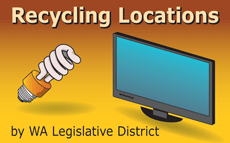Mercury Reports
Turning Up The Heat II: Exposing the continued failures of the manufacturers' thermostat recycling program
A manufacturer-run program for collecting mercury thermostats is failing to keep the toxic heavy metal out of the trash - and the environment - in most states, according to this report (PDF) from the Multi-State Mercury Products Campaign (MMPC). Prepared by the Natural Resources Defense Council, Product Stewardship Institute, Clean Water Fund, and Mercury Policy Project, April 2013.
Recommendations for a Mercury Containing Light Recycling Program in Washington State.
The Washington Department of Ecology released their report on Recommendations for a Mercury Containing Light Recycling Program in Washington State (PDF) in November 2009 as directed by the Washington State Legislature. The report outlines Ecology's recommendations for a convenient and effective mercury-containing light recycling program for residents, small businesses, and small school districts throughout the state.
2002 Report on Washington's Mercury-Contaminated Fish.
The Washington Toxics Coalition and WashPIRG released Reel Trouble: How Washington's Fish-Advisory Program Fails to Protect Consumers from Toxic Fish (PDF). The report documents mercury contamination of fish in bodies of water throughout Washington. It also has recommendations for the Department of Health to improve the protection of the state's residents.
Environmental Release of Mercury from Broken Compact Fluorescent Lamps.
Environmental Engineering Science, Volume 28, Number 10, 2011
Mercury-Added Lamps - A Strategy for Improving Recycle Rates (PDF)
Maine Department of Environmental Protection. February, 2010
Review of Compact Fluorescent Lamp Recycling Initiatives in the U.S. and Internationally (PDF)
Northeast Waste Management Officials’ Association (NEWMOA). July 9, 2009
Initial Risk-Based Prioritization of Mercury in Certain Products (PDF).
U.S. Environmental Protection Agency. November 2008. This preliminary assessment describes uses of elemental mercury in a number of products and encourages the use of mercury-free alternatives.
Spatial Assessment of Net Mercury Emissions from the Use of Fluorescent Bulbs.
ASAP Environmental Science & Technology, ASAP Article, 10.1021/es800117h. October 1, 2008.
California AB 1109 Lighting Task Force Final Report - Recommendations for Collection and Recycling of Spent Fluorescent Bulbs in California (PDF).
California Department of Toxic Substances Control. September 1, 2008.
Product Stewardship Action Plan for Fluorescent Lighting (PDF).
Product Stewardship Institute. June 30, 2008.
Shedding Light on Mercury Risks from CFL Breakage.
The Mercury Policy Project. February 2008.
Maine Compact Fluorescent Lamp Breakage Study Report.
Maine Department of Environmental Protection. February 2008.
Fluorescent Lamp Recycling in Washington State: Recycling Levels, Stakeholder Analysis, and Policy Options (PDF).
Cascadia Consulting Group. June 2007.
Mercury and IQ: Dose-Response Estimate of Prenatal Effect (PDF).
Environmental Health Perspectives. Vol. 115, No. 4. April 2007.
Mercury Matters (PDF). The Hubbard Brook Research Foundation. January 2007.
Cap and trade policies have created mercury hotspots which not only elevates the level of mercury in contaminated areas, but also has the ability to spread regionally, nationally, and world wide.
Curtailing Mercury’s Global Reach (PDF).
State of the World: 2006. The World Watch Institute. 2006.
Release of Mercury from Broken Fluorescent Bulbs (PDF).
New Jersey Department of Environmental Protection. February 2004.
An Investigation of Alternatives to Mercury Containing Products (PDF).
Lowell Center for Sustainable Production. January 22, 2003.
